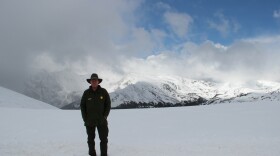Whether ozone is a pollutant or not depends on where it is in the atmosphere. At high elevations, in the stratosphere, it shields the earth from ultraviolet radiation, keeping people cool. But closer to the ground, it's a pollutant.
The Environmental Protection Agency limits ozone levels in the atmosphere, and they've recommended lowering the limit again. Yet while it might help people breathe easier, many U.S. counties don't comply with the current limit. A new analysis published in Science from a researcher at the University of Colorado-Boulder finds that it's hard to figure out who is producing ozone in order to decrease the amount in the air.
"Some of what you breathe every day is ozone from the stratosphere," says Owen Cooper, a researcher at the Cooperative Institute for Research in Environmental Sciences. "It's the same ozone; it's three oxygen molecules bound together." For example, the strong tornado-producing storms in the Midwest often churn more ozone into the lower atmosphere during the springtime.
But there's not enough ozone just from the stratosphere to cause health problems. It's only when you add in ozone from human activities – like burning fossil fuels, gassing up the car, and using oil-based paint – that the levels get high enough to threaten human health.
"Some people have described it sort of like a sunburn of the lungs," says Janet McCabe, Acting Assistant Administrator for the Office of Air and Radiation at the EPA. "It can inflame the lining of the lungs, and it can bring on or worsen bronchitis, emphysema, and asthma. It can also cause things such as chest pain coughing, throat irritation, and congestion."
"Our own ozone circles the globe and comes back from across the Pacific."
The current limit for atmospheric ozone is 75 parts per billion – for every billion air molecules there must be fewer than 75 ozone molecules. Yet Cooper reports that as of 2013, 227 counties across the United States don't comply with the current ozone limitation – affecting about 123 million people. Dropping that limit to 70 parts per billion, or even 65, as the EPA recommends, would increase the number of noncompliant counties to 358 and 558, respectively.
Getting people to comply with the limitation means figuring out who's producing the extra ozone. There's no way for CU researcher Cooper to tell where exactly the ozone molecules come from. But sometimes he can find clues in the air around the ozone. Water vapor in the air suggests the air mass came from a more tropical location, he says. Certain elements in the air might indicate that the ozone came from an area of fossil fuel combustion.
A lot of the ozone that Cooper measures here comes from outside of the U.S., which means that curbing fossil fuel use in the U.S. won't necessarily help some areas reach the limit.
"We're finding that along the West of the United States there's an abundance of ozone that flows in from across the Pacific originating from either Asia or natural sources," says Cooper. These measurements make up baseline data – ozone levels before the air crosses the country and picks up U.S.-produced ozone to the atmosphere.
"Some of what you breathe every day is ozone from the stratosphere."
Unless it's already been around the world. Since ozone molecules last for 10 – 30 days, says Cooper, "Our own ozone circles the globe and comes back from across the Pacific."
Right now, the baseline measurements are infrequent at best. That means that Cooper and other atmospheric researchers can only estimate how much ozone the U.S. adds to the atmosphere.
"It's a bit like lying on your back on the coast of California for a whole week," says Cooper. "You open your eyes for about two seconds and take a snap measurement of ozone and close your eyes for the rest of the week."
Yet he and the EPA do see an impact in emissions restrictions already in place.
"The good news is that ozone is coming down across the country," says Cooper. It takes a while for newer vehicles to replace older ones on the road, but as automobile technology improves, ozone pollution improves as well. And McCabe says that the EPA predicts ozone levels will continue to decline.
"We have a lot of programs in place that will continue to bring emissions down without us passing any more rules," she says.
But whether the improvements will be enough to meet EPA restrictions is another matter.
"In rural areas where there's still very little locally produced ozone," says Cooper, "those areas that already exceed 70 or 60 ppb will have a difficult time complying with the standard."






